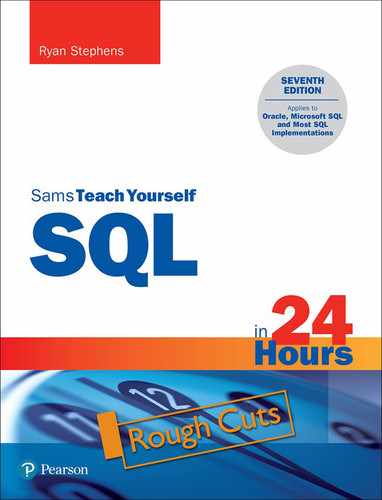Includes Coverage of Oracle and Microsoft SQL Implementations In just 24 lessons of one hour or less, SQL in 24 Hours, Sams Teach Yourself, Seventh Edition, helps you use SQL to build effective databases, efficiently retrieve data, and manage everything from performance to security. The straightforward, step-by-step approach shows you how to work with database structures, objects, queries, tables, and more. In just hours, you will be applying advanced techniques, including views, transactions, web connections, and powerful Oracle and SQL Server extensions. Every lesson builds on what youve already learned, giving you a rock-solid foundation for real-world success. Step-by-step instructions carefully walk you through the most common SQL tasks. Practical, hands-on examples show you how to apply what you learn. Quizzes and exercises help you test your knowledge and stretch your skills. Notes and tips point out shortcuts and solutions. Learn how to Define efficient database structures and objects Normalize raw databases into logically organized tables Edit relational data and tables with DML Manage transactions Write effective, well-performing queries Categorize, summarize, sort, group, and restructure data Work with dates and times Join tables in queries, use subqueries, and combine multiple queries Master powerful query optimization techniques Administer databases and manage users Secure databases and protect data Use views, synonyms, and the system catalog Extend SQL to the enterprise and Internet Master important Oracle and Microsoft extensions to ANSI SQL Register your product at informit.com/register for convenient access to downloads, updates, and corrections as they become available.
Table of Contents
- Cover Page
- Title Page
- Copyright Page
- Contents at a Glance
- Table of Contents
- About the Authors
- Dedication
- Acknowledgments
- We Want to Hear from You!
- Reader Services
- What This Book Is About
- What You Need for This Book
- Author’s Website
- Preface
- Hour 1 Understanding the Relational Database and SQL
- Hour 2 Exploring the Components of the SQL Language
- Hour 3 Getting to Know Your Data
- Hour 4 Setting Up Your Database
- Hour 5 Understanding the Basics of Relational (SQL) Database Design
- Hour 6 Defining Entities and Relationships
- Hour 7 Normalizing Your Database
- Hour 8 Defining Data Structures
- Hour 9 Creating and Managing Database Objects
- Hour 10 Manipulating Data
- Hour 11 Managing Database Transactions
- Hour 12 Introduction to Database Queries
- Hour 13 Using Operators to Categorize Data
- Hour 14 Joining Tables in Queries
- Hour 15 Restructuring the Appearance of Data
- Hour 16 Understanding Dates and Times
- Hour 17 Summarizing Data Results from a Query
- Hour 18 Using Subqueries to Define Unknown Data
- Hour 19 Combining Multiple Queries into One
- Hour 20 Creating and Using Views and Synonyms
- Hour 21 Managing Database Users and Security
- Hour 22 Using Indexes to Improve Performance
- Hour 23 Improving Database Performance
- Hour 24 Working with the System Catalog
- Hour 25 Bonus Workshop for the Road
- The BIRDS Database
- Predators of Birds
- Photographers of Birds
- Creating the New Tables
- Workshop: Describing Your Tables
- Workshop: Basic Queries
- Workshop: Adding Tables
- Workshop: Manipulating Data
- Workshop: Joining Tables
- Workshop: Comparison Operators
- Workshop: Logical Operators
- Workshop: Conjunctive Operators
- Workshop: Arithmetic Operators
- Workshop: Character Functions
- Workshop: Aggregating Data
- Workshop: GROUP BY and HAVING
- Workshop: Composite Queries
- Workshop: Creating Tables from Existing Tables
- Workshop: Inserting Data into a Table from Another Table
- Workshop: Creating Views
- Workshop: Embedding Subqueries
- Workshop: Creating Views from Subqueries
- Workshop: Generating SQL Code from a SQL Statement
- Summary
- Workshop
- Appendix A Common SQL Commands
- Appendix B Popular Vendor RDBMS Implementations
- Appendix C Answers to Quizzes and Exercises
- Hour 1, “Understanding the Relational Database and SQL”
- Hour 2, “Exploring the Components of the SQL Language”
- Hour 3, “Getting to Know Your Data”
- Hour 4, “Setting Up Your Database”
- Hour 5, “Understanding the Basics of Relational (SQL) Database Design”
- Hour 6, “Defining Entities and Relationships”
- Hour 7, “Normalizing Your Database”
- Hour 8, “Defining Data Structures”
- Hour 9, “Creating and Managing Database Objects”
- Hour 10, “Manipulating Data”
- Hour 11, “Managing Database Transactions”
- Hour 12, “Introduction to Database Queries”
- Hour 13, “Using Operators to Categorize Data”
- Hour 14, “Joining Tables in Queries”
- Hour 15, “Restructuring the Appearance of Data”
- Hour 16, “Understanding Dates and Times”
- Hour 17, “Summarizing Data Results from a Query”
- Hour 18, “Using Subqueries to Define Unknown Data”
- Hour 19, “Combining Multiple Queries into One”
- Hour 20, “Creating and Using Views and Synonyms”
- Hour 21, “Managing Database Users and Security”
- Hour 22, “Using Indexes to Improve Performance”
- Hour 23, “Improving Database Performance”
- Hour 24, “Working with the System Catalog”
- Hour 25, “Bonus Workshop for the Road”
